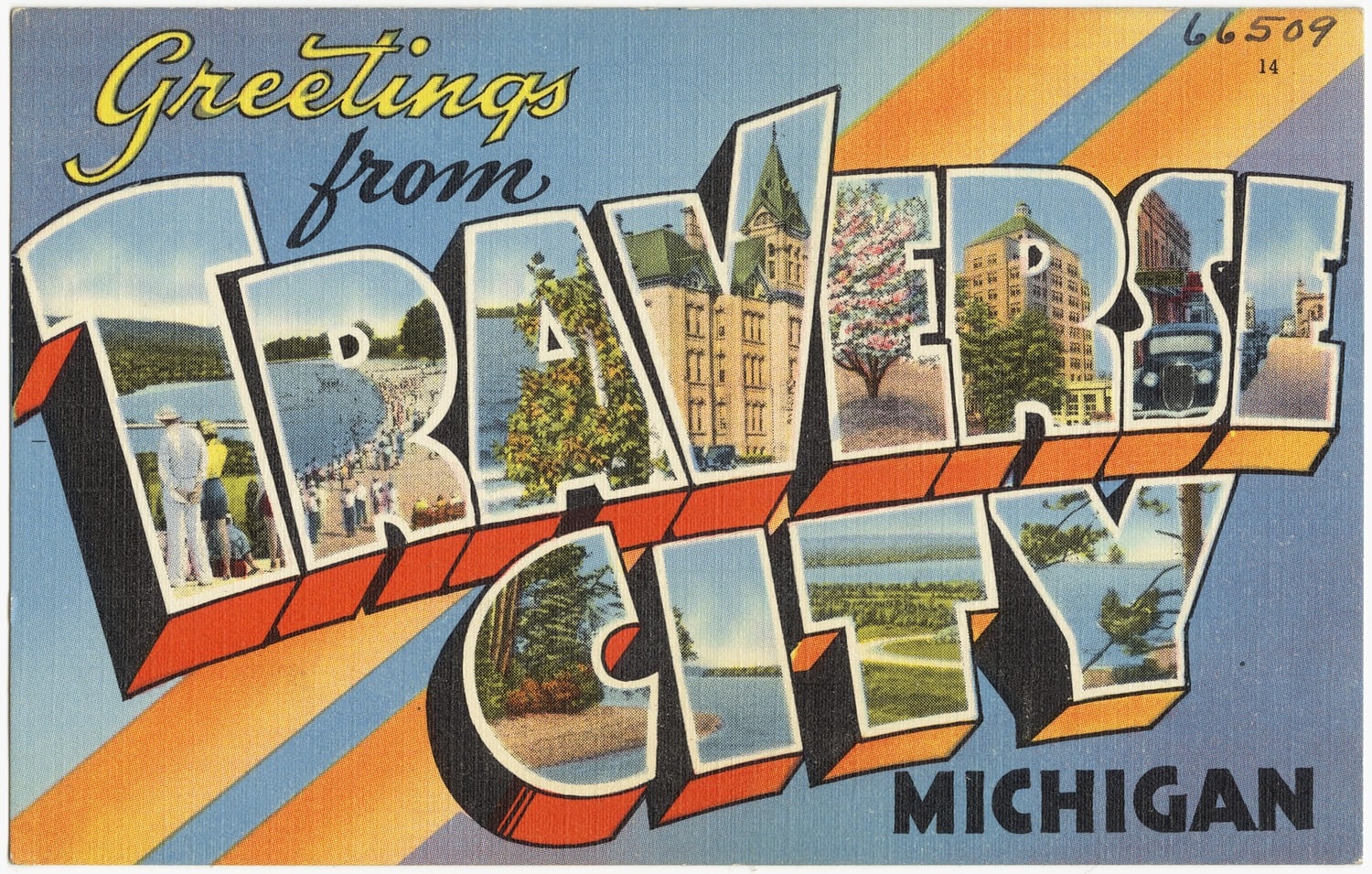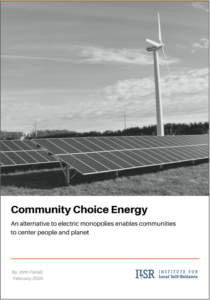Voices Of 100%: Michigan City Sets Steady Pace To A Clean Electricity Goal
Originally published at ILSR.org
Many cities have already proven the possibility of 100% clean, renewable electricity. For those that are still working towards this goal, patience and persistence are one way to get there.
For this episode of our Voices of 100% series of the Local Energy Rules Podcast, host John Farrell speaks with Traverse City Light and Power board members Amy Shamroe and Tim Werner. Both are also city commissioners, with Shamroe serving as Mayor Pro Tem. Informed by their experience at the intersection between city government and a city-owned utility, the two describe how Traverse City set a goal of 100% renewable energy and how the utility plans to implement it.
Listen to the full episode and explore more resources below — including a transcript and summary of the conversation.
Podcast (localenergyrules): Play in new window | Download | Embed
Subscribe: Apple Podcasts | Android | Stitcher | RSS
Episode Transcript
“We’re a Little Blue Dot in a Sea of Red and Purple”
Traverse City is a town of 15,000 on the shore of Lake Michigan. Although the city committed to powering municipal operations with clean energy by 2020 in 2016, commissioners didn’t make the jump to a community-wide commitment until 2018. The city, and its municipal utility, are now committed to providing 100% clean, renewable energy by 2040. It was the first Michigan city to commit to 100% renewable electricity community-wide.
Mayor Pro Tem Amy Shamroe believes that the 100% goal, although city residents lean progressive, can be attributed to a local appreciation for the natural environment. As a key part of the economy, through tourism and industry, a mission to preserve Lake Michigan unifies the residents of Traverse City.

As Shamroe describes, the process of making the commitment was not smooth. Still, there was not much protest. Residents of Traverse City understood why the commission wanted to make a commitment, but the question remained, how would they reach their goal?
The City Commission Leads the Way
When the city commission passed its first 100% resolution in 2016, for city facilities, it acted autonomously. As Shamroe and Werner describe, there was some tension between the city and the Light and Power board. The city wanted to move forward, regardless of where the utility stood on the issue. Werner describes the city’s plan as naive:
With the hat of the city commission on, we can just be naive politicians. We don’t have to know how it can be done or whether it will be done necessarily, we can just say this is what we want to happen.
– Tim Werner
Shamroe waters down Werner’s statement. As an engineer, says Shamroe, Werner was never naive about the goal’s implementation. However, since city facilities are only a fraction of energy use within Traverse City, the goal was within reach.
Traverse City had the opportunity to purchase the energy from a one megawatt solar array. The energy would come at a premium, but it would be built on the edge of town. The visibility was a selling point, says Werner. Plus, the developers were able to build it right away. The City Commission unanimously approved the purchase of energy from the array.
Partnering with a City-Owned Utility
Werner says that there is a “flexibility and nimbleness” to a small, city-owned utility. These characteristics will help the transition to clean energy — a fact made apparent by some of the cities that have already achieved their 100% renewable goals, like Burlington, Vt. and Georgetown, Texas. Both cities own their utility companies.
Shamroe says that Traverse City has taken some inspiration from Burlington, because it has achieved its goal in a similar climate zone. However, even with their similarities, varying political and environmental climates mean that every city has a unique path to 100 percent. Each community is different and has its own needs.
Our shareholders, if you will, are our residents… ultimately, we answer to them
– Amy Shamroe
Sharing the Benefits, While Keeping Costs Low
Shamroe is proud that Traverse City Light and Power offers one of the lowest electricity rates in the state of Michigan. Although the board of the utility is evolving, she and the other members maintain a focus on affordable rates. She does not want residents to have to choose between clean energy and low energy prices.
People are seeing that this is a goal, they’re on board for the goal. Because we are doing it in a way that’s not hitting them right in the wallet, we’re keeping them with us through the process and keeping them in mind the whole time.
– Amy Shamroe
How Much Progress has the City Made?
Traverse City’s original goal was to power city operations with 100% renewable energy by 2020. With the help of purchased renewable energy credits, the city is technically there. Werner thinks of the purchased credits as a bridge, because the city plans to generate more renewable energy itself.
Werner says that the city is still paying a premium for the one megawatt solar project. Depending how the market rate for energy changes, the megawatt of solar could save the city money in the future.
So yes, that 1 megawatt on the edge of town for traverse city proper is at a premium, but in the grand scheme of things, the multimillion dollar budget for light and power, it’s in the noise and it has no effect on rate payers.
– Tim Werner
The cost of renewables is not the problem. Rather, Traverse City is stuck in some long-term coal contracts that are keeping it from its goal. The city has considered breaking the contracts, but Shamroe fears it will be too costly for ratepayers. The longer of the two contracts expires in 2035, which is why the city set 2040 as the year to reach 100% clean electricity.
Even if we could break those contracts somehow… If they’re just going to sell that electricity from coal to somebody else at a cheap rate because we broke the contract so we can be renewable, does that really make the world a better place?
– Tim Werner
See Traverse City’s 1 MW solar panel on the cover of our community choice energy report:

Final Words of Wisdom
When Farrell asks the interviewees for their advice, Shamroe says to not get too bogged down in the “how.” If a city wants to run on clean energy, it is important to set the tone by setting a goal.
It’s not some pie in the sky dream. It’s going to be doable, and all of us together make it more probable that it will happen in a timely manner, because there’s demand now — and that’s capitalism.
– Amy Shamroe
Werner’s advice to other city leaders is to set goals that are aspirational, but not impossible.
Pick a realistic date, but there’s still stretch goals. Things you really are going to have to work for — cause you can get the community behind that. Then they feel like, hey, this is something we are going to work toward, but it’s not some huge burden.
– Tim Werner
Episode Notes
See these ILSR resources for more behind the story:
- Listen to our Voices of 100% feature on Burlington, Vt.
- Read this report on how municipal utilities can establish equitable community solar programs.
For concrete examples of how cities can take action toward gaining more control over their clean energy future, explore ILSR’s Community Power Toolkit.
Explore local and state policies and programs that help advance clean energy goals across the country, using ILSR’s interactive Community Power Map.
 This is the 20th episode of our special Voices of
This is the 20th episode of our special Voices of ![]() series, and episode 102 of Local Energy Rules, an ILSR podcast with Energy Democracy Director John Farrell, which shares powerful stories of successful local renewable energy and exposes the policy and practical barriers to its expansion.
series, and episode 102 of Local Energy Rules, an ILSR podcast with Energy Democracy Director John Farrell, which shares powerful stories of successful local renewable energy and exposes the policy and practical barriers to its expansion.
This article originally posted at ilsr.org. For timely updates, follow John Farrell on Twitter, our energy work on Facebook, or sign up to get the Energy Democracy weekly update.
Featured Photo Credit: XTRAICE Synthetic Ice Rinks via Flickr (CC BY 2.0)
Have a tip for CleanTechnica? Want to advertise? Want to suggest a guest for our CleanTech Talk podcast? Contact us here.
Latest CleanTechnica.TV Video

CleanTechnica uses affiliate links. See our policy here.
